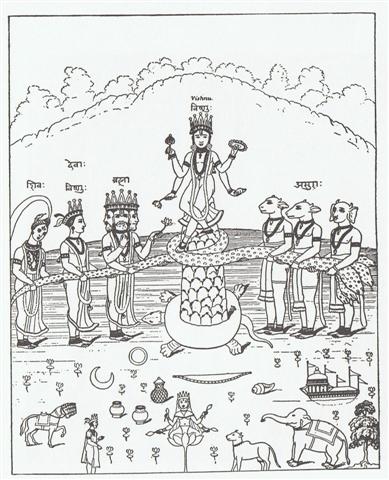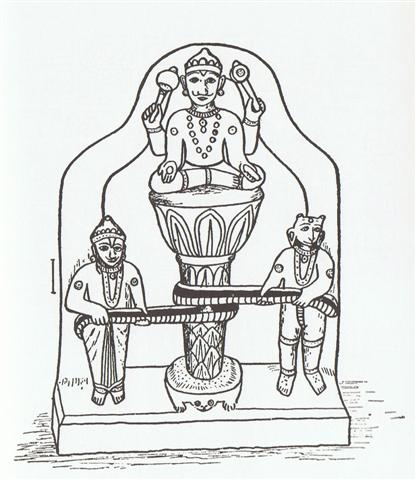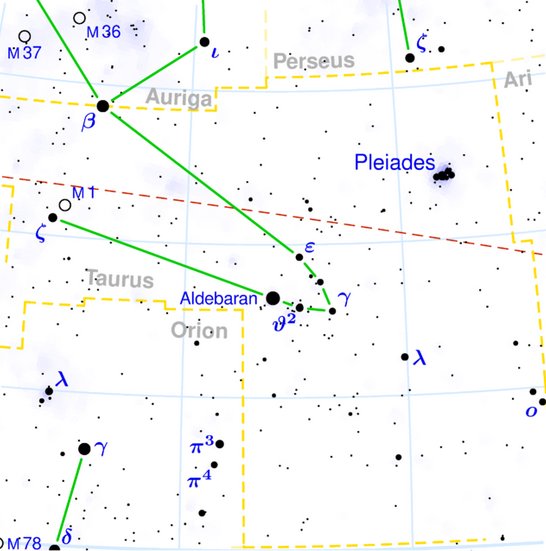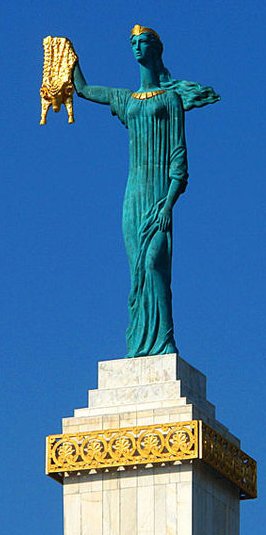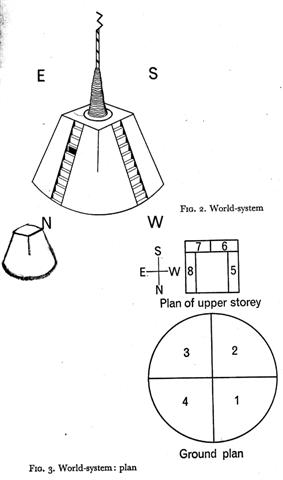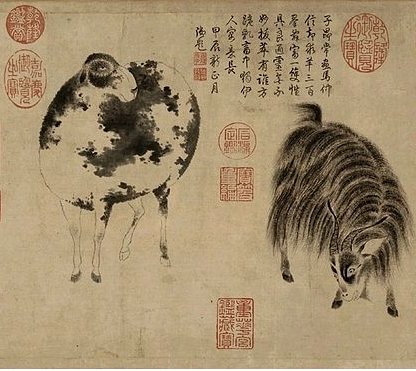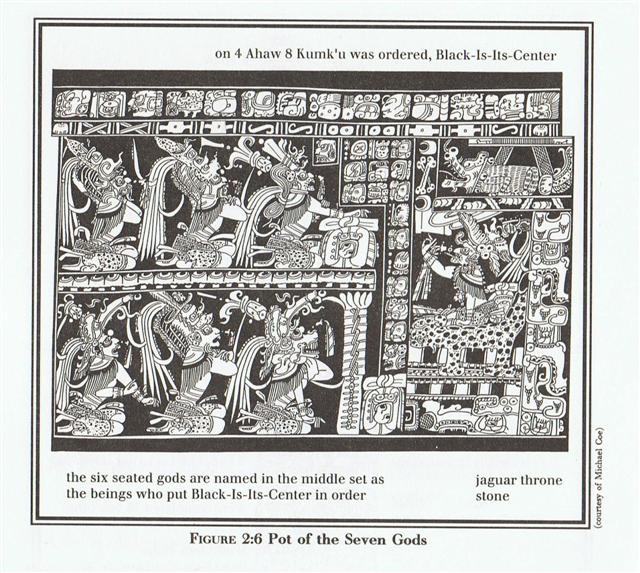The distance from the star at the Chinese Crow (or Net) station (Ain, ε Tauri) to Raven (Alchita, α Corvi) had always (as far as would have been known) been 118 days (4 lunar synodic months), and evidently the G text was designed with a structure measuring out 4 * 118 = 472 nights. This cycle was 107 nights longer than that of the Gregorian (non-leap) year and 108 nights longer than 52 weeks (= 364 nights). It was also 40 nights longer than 432 (= 12 * 36 = 16 * 27):
... On the last day, they issue forth to battle in martial array. Says Grimnismal (23): 'Five hundred gates and forty more - are in the mighty building of Walhalla - eight hundred 'Einherier' come out of each one gate - on the time they go out on defence against the Wolf.' That makes 432,000 in all, a number of significance from of old. This number must have had a very ancient meaning, for it is also the number of syllables in the Rigveda. But it goes back to the basic figure 10,800, the number of stanzas in the Rigveda (40 syllables to a stanza) which, together with 108, occurs insistently in Indian tradition, 10,800 is also the number which has been given by Heraclitus for the duration of the Aiōn, according to Censorinus (De die natali, 18), whereas Berossos made the Babylonian Great Year to last 432,000 years. Again, 10,800 is the number of bricks of the Indian fire-altar (Agnicayana) ... Shall one add Angkor to the list? It has five gates, and to each of them leads a road, bridging over that water ditch which surrounds the whole place. Each of these roads is bordered by a row of huge stone figures, 108 per avenue, 54 on each side, altogether 540 statues of Deva and Asura, and each row carries a huge Naga serpent with nine heads. Only, they do not 'carry' that serpent, they are shown to 'pull' it, which indicates that these 540 statues are churning the Milky Ocean, represented (poorly, indeed) by the water ditch, using Mount Mandara as a churning staff, and Vasuki, the prince of the Nagas, as their drilling rope ...
The 'incomparably mighty churn' of the Sea of Milk, as described in the Mahabharata and Ramayana. The heads of the deities on the right are the Asura, with unmistakable 'Typhonian' characteristics. They stand for the same power as the Titans, the Turanians, and the people of Untamo, is short, the 'family' of the bad uncle, among whom Seth is the oldest representative, pitted against Horus, the avenger of his father Osiris ...
The simplified version of the Amritamanthana (or Churning of the Milky Ocean) still shows Mount Mandara used as a pivot or churning stick, resting on the tortoise. And here, also, the head on the right has 'Typhonian' features. The whole of Angkor thus turns out to be a colossal model set up for 'alternative motion' with true Hindu fantasy and incongruousness ... The Pleiades did no longer rise heliacally early in spring but in May, and from the 6 stones (Tau-ono) to the Eye of the Bull (Ain, ε Tauri) there were 9 days (as many as the heads of the Naga serpent):
... The Euripus, which has already come up in the Phaedo, was really a channel between Euboea and the mainland, in which the conflict of the tides reverses the current as much as seven times a day, with ensuing dangerous eddies - actually a case of standing waves rather than a true whirl. We meet the name again at a rather unexpected place, in the Roman circus or hippodrome, as we know from J. Laurentius Lydus (De Mensibus I.12), who states that the center of the circus was called Euripos; that in the middle of the stadium was a pyramid, belonging to the Sun; that by the Sun's pyramid were three altars, of Saturn, Jupiter, Mars, and below the pyramid, altars of Venus, Mercury, and the Moon, and that there were not more than seven circuits (kykloi) around the pyramid, because the planets were only seven. (See also F. M. Cornford's chapter on the origin of the Olympic games in J. Harrison's Themis (1962), p. 228; G. Higgins' Anacalypsis (1927), vol. 2., pp. 372ff.) This brings to mind (although not called Euripus, obviously, but 'the god's place of skulls') the Central American Ball Court which had a round hole in its center, termed by Tezozomoc 'the enigmatic significance of the ball court', and from this hole a lake spread out before Uitzilopochtli was born. See W. Krickeberg, 'Der mittelamerikanische Ballspielplatz und seine religiöse Symoblik', Paideuma 3 (1948), pp. 135ff., 155, 162. And here the unstable Euripus of the Ocean, which flows back to the beginnings of its mysterious source, dragged with irresistible force the unhappy sailors, thinking by now only of death, towards Chaos. This is said to be the maw of the abyss, that unknown depth in which, it is understood, the ebb and flow of the whole sea is absorbed and then thrown up again, which is the cause of the tides. This is reflection of what had been a popular idea of antiquity. But here comes a version of the same story in North America. It concerns the canoe adventures of two Cherokees at the mouth of Suck Creek. One of them was seized by a fish, and never seen again. The other was taken round and round to the very lowest center of the whirlpool, when another circle caught him and bore him outward. He told afterwards that when he reached the narrowest circle of the maelstroem the water seemed to open below and he could look down as through the roof beam of a house, and there on the bottom of the river he had seen a great company, who looked up and beckoned to him to join them, but as they put up their hands to seize him the swift current caught him and took him out of their reach. It is almost as if the Cherokees have retained a better memory, when they talk of foreign regions, inhabited by 'a great company' - which might equally well be the dead, or giants with their dogs - there, where in 'the narrowest circle of the maelstroem the water seemed to open below' ...
... Tre volte il fe' girar con tutte l'acque // alla quarta voltar la poppa in suso // e la prora ire in giu, com'altrui piacque // Infin che'l mar fu sopra noi richiuso. Dante kept to the tradition of the whirlpool as a significant end for great figures, even if here it comes ordained by Providence. Ulysses has sailed in his 'mad venture' beyond the limits of the world, and once he has crossed the ocean he sees a mountain looming far away, 'hazy with the distance, and so high I had never seen any.' It is the Mount of Purgatory, forbidden to mortals. 'We rejoiced, and soon it turned to tears, for from the new land a whirl was born, which smote our ship from the side. Three times it caused it to revolve with all the waters, on the forth to lift is stern on high, and the prow to go down, as Someone willed, until the sea had closed over us.' The 'many thoughted' Ulysses is on his way to immortality, even if it has to be Hell. The engulfing whirlpool belongs to the stock-in-trade of ancient fable. It appears in the Odyssey as Charybdis in the straits of Messina - and again, in other cultures, in the Indian Ocean and in the Pacific. It is found there too, curiously enough, with the overhanging fig tree to whose boughs the hero can cling as the ship goes down, whether it be Satyavrata in India, or Kae in Tonga ...
... The Symplegades ... or Clashing Rocks, also known as the Cyanean Rocks, were, according to Greek mythology, a pair of rocks at the Bosphorus that clashed together randomly. They were defeated by Jason and the Argonauts, who would have been lost and killed by the rocks except for Phineus' advice. Jason let a dove fly between the rocks; it lost only its tail feathers. The Argonauts rowed mightily to get through and lost only part of the stern ornament. After that, the Symplegades stopped moving permanently ...
The Argonauts, with the Golden Fleece on board, had to pass the Symplegades, the clashing rocks. Once a ship with its crew came through unharmed - so the 'blessed ones' (makaroi) had decided long ago - the Symplegades would stay fixed, and be clashing rocks no longer. After that 'accepting the novel laws of the fixed earth', they should 'offer an easy passage to all ships, once thay had learnt defeat'. This is only one station on the long 'opening travel' of the Argonauts transporting the Golden Fleece (of a ram), undertaken in all probability to introduce the Age of Aries, but it demonstrates best the relevant point, namely, 'the novel laws' ...
... An iconographic study by Jeff Kowalski suggests a cosmological layout for the Nunnery. The higher placement of the North Building, with its 13 exterior doorways (reflecting the 13 layers of heaven), and the celestial serpents surmounting the huts identify it with the celestial sphere. The iconography of the West Building, with 7 exterior doorways (7 is the mystic number of the earth's surface), and figures of Pawahtun - the earth god as a turtle - indicate this to be the Middleworld, the place of the sun's descent into the Underworld. The East Building has mosaic elements reflecting the old war cult of Teotihuacan, where tradition had it that the sun was born; thus, this may also be Middleworld, the place of the rising sun. Finally, the South Building has 9 exterior doorways (the Underworld or Xibalba had 9 layers), and has the lowest placement in the compex; it thus seems to be associated with death and the nether regions ...
Nine black new moon dots (•) adorns the forehead of the Easter Island woman in the picture above, below her boatformed hat (hau) and with earlobes hanging down empty - without any pua tariga. The time was still winter, and there was no fire, i.e. they walked together in a great company - like the stars when the Sun was absent. ... They walked in crowds when they arrived at Tulan, and there was no fire ...
... When it was evident that the years lay ready to burst into life, everyone took hold of them, so that once more would start forth - once again - another (period of) fifty-two years. Then (the two cycles) might proceed to reach one hundred and four years. It was called 'One Age' when twice they had made the round, when twice the times of binding the years had come together. Behold what was done when the years were bound - when was reached the time when they were to draw the new fire, when now its count was accomplished. First they put out fires everywhere in the country round. And the statues, hewn in either wood or stone, kept in each man's home and regarded as gods, were all cast into the water. Also (were) these (cast away) - the pestles and the (three) hearth stones (upon which the cooking pots rested); and everywhere there was much sweeping - there was sweeping very clear. Rubbish was thrown out; none lay in any of the houses ... Metoro's hau could have suggested the tuna fishing line (hau kahi) - in the east there was a rising vaha mea tuna in the next day and this 'gentleman' seems to have come ashore with the power of a hurricane (huga). ... I'a is the general name for fishes,' Pratt notes in his Samoan dictionary, 'except the bonito and shellfish (mollusca and crustacea).' We may forgive the inaccuracy of the biology in our gratitude for the former note. The bonito is not a fish, the bonito is a gentleman, and not for worlds would Samoa offend against his state. The Samoan in his 'upu fa'aaloalo has his own Basakrama, the language of courtesy to be used to them of high degree, to chiefs and bonitos. One does not say that he goes to the towns which are favorably situated for the bonito fishery; he says rather that (funa'i) he goes into seclusion, he withdraws himself. He finds that the fleet which is to chase the bonito has an honourable name for this use, that the chief fisher has a name that he never uses ashore. He will not in so many words say that he is going to fish for bonito, he says that he is going out paddling in the courtesy language (alo); he even avoids all chance of offending this gentleman of his seas by saying, instead of the blunt vulgarity of the word fishing, rather that he is headed in some other direction (fa'asanga'ese). He does not paddle with the common word but with that (pale) which he uses in compliment to his chief's canoe. He will not so much as speak the word which means canoe; he calls it by another word (tafānga), which may mean the turning away to one side. In this unmentioned canoe he may not carry water by its common name, he must call it (mālū) the cool stuff. He will not mention his eyes in the canoe; he calls his visor (taulauifi) the shield for his chestnut leaves. Even the word for large becomes something else (sumalie) in this great game. The hook must be tied with ritual care; it is called (pa) out of the common name for hook; no bonito will take a hook which has not been properly tied; the fastening is veiled under the name (fanua) for the land. There are many rules to observe; their disregard is called (sopoliu) the stepping over the bilges, from the most unfortunate thing that the fisher can do. He may hail the bonito by his name (atu), or he may call him affectionately or coaxingly (pa'umasunu) old singed-skin. If he has the fortune to hook his bonito he must raise the shout of triumph, Tu! Tu! Tu e!, not his whole name but one of its syllables; he triumphs as over a foe honorably slain in combat, but he avoids hurting the feelings of the other gentlemen of the sea. The first bonito caught in a new canoe he calls (ola) life; the first bonito caught in any season bears a special name (ngatongiā), of uncertain signification, and he presents it to his chief. His catch he reckons by a special notation; to his numerals he adds the word (tino) body; he counts them as one-body, two-body, three-body. Parts of the gentleman have specific names of their own; his fins (asa) and his entrails (fe'afe'a) are called in terms nowhere else employed; the tidbit of the belly part, which the fisher must give to his chief, is called (ma'alo) by the honorific title of the chief's abdomen. And if the rites were not duly observed, if the hook was not rightly tied, if the fisher was so incautious as to mention his eyes, if one of a hundred faults was committed and the fishing was in vain, then the fisher acknowledged his ill success abjectly by saying that (maloā) he was conquered. Such is the language Samoans use to the gentleman of the seas, and he is not i'a ...
... What happens after (or happened, or will happen sometime, for this myth is written in the future tense), is told in the Völuspa, but it is also amplified in Snorri's Gylfaginning (53), a tale of a strange encounter of King Gylfi with the Aesir themselves, disguised as men, who do not reveal their identity but are willing to answer questions: 'What happens when the whole world has burned up, the gods are dead, and all of mankind is gone? You have said earlier, that each human being would go on living in this or that world.' So it is, goes the answer, there are several worlds for the good and the bad. Then Gylfi asks: 'Shall any gods be alive, and shall there be something of earth and heaven?' And the answer is: 'The earth rises up from the sea again, and is green and beautiful and things grow without sowing. Vidar and Vali are alive, for neither the sea nor the flames of Surt have hurt them and they dwell on the Eddyfield, where once stood Asgard. There come also the sons of Thor, Modi and Magni, and bring along his hammer. There come also Balder and Hoder from the other world. All sit down and converse together. They rehearse their runes and talk of events of old days. Then they find in the grass the golden tablets that the Aesir once played with. Two children of men will also be found safe from the great flames of Surt. Their names, Lif and Lifthrasir, and they feed on the morning dew and from this human pair will come a great population which will fill the earth. And strange to say, the sun, before being devoured by Fenrir, will have borne a daughter, no less beautiful and going the same ways as her mother.' Then, all at once, concludes Snorri's tale wryly, a thunderous cracking was heard from all sides, and when the King looked again, he found himself on the open plain and the great hall had vanished ... The pair of days defined by Hyadum I and Hyadum II (δ) were like doorposts in front of the open plain:
And the great hall (Walhalla, etc) was probably referring to the region of the northern polar cap. ... the great high priest and monarch of the Golden Age in the Toltec city of Tula, the City of the Sun, in ancient Mexico, whose name, Quetzalcoatl, has been read to mean both 'the Feathered Serpent' and 'the Admirable Twin', and who was fair of face and white of beard, was the teacher of the arts to the people of pre-Columbian America, originator of the calendar, and their giver of maize. His virgin mother, Chimalman - the legend tells - had been one of the three sisters to whom God, the All-Father, had appeared one day under his form of Citlallatonac, 'the morning'. The other two had been struck by fright, but upon Chimalman God breathed and she conceived. She died, however, giving birth, and is now in heaven, where she is revered under the honourable name of 'the Precious Stone of Sacrifice', Chalchihuitzli. Quetzalcoatl, her child, who is known both as the Son of the Lord of the High Heavens and as the Son of the Lord of the Seven Caves, was endowed at birth with speech, all knowledge, and all wisdom, and in later life, as priest-king, was of such purity of character that his realm flourished gloriously throughout the period of his reign. His temple-palace was composed of four radiant apartments: one toward the east, yellow with gold; one towards the west, blue with turquoise and jade; one toward the south, white with pearls and shells; one towards the north, red with bloodstones - symbolizing the cardinal quarters of the world over which the light of the sun holds sway. And it was set wonderfully above a mighty river that passed through the midst of the city of Tula; so that every night, precisely at midnight, the king descended into the river to bathe; and the place of his bath was called 'In the Painted Vase', or 'In the Precious Waters' ...
... All was now ready for departure except that there was no fire in the smithy. The ancestor slipped into the workshop of the great Nummo, who are Heaven's smiths, and stole a piece of the sun in the form of live embers and white-hot iron. He seized it by means of a 'robber's stick' the crook of which ended in a slit, open like a mouth.
He dropped some of the embers, came back to pick them up, and fled towards the granary; but his agitation was such that he could no longer find the entrances. He made the round of it several times before he found the steps and climbed onto the flat roof, where he hid the stolen goods in one of the skins of the bellows, exclaiming: 'Gouyo!', which is to say. 'Stolen!'. The word is still part of the language, and means 'granary'. It is a reminder that without the fire of the smithy and the iron of hoes there would be no crops to store ...
During his descent the ancestor still possessed the quality of a water spirit, and his body, though preserving its human appearance, owing to its being that of a regenerated man, was equipped with four flexible limbs like serpents after the pattern of the arms of the Great Nummo. The ground was rapidly approaching. The ancestor was still standing, his arms in front of him and the hammer and anvil hanging across his limbs. The shock of his final impact on the earth when he came to the end of the rainbow, scattered in a cloud of dust the animals, vegetables and men disposed on the steps. When calm was restored, the smith was still on the roof, standing erect facing towards the north, his tools still in the same position. But in the shock of landing the hammer and the anvil had broken his arms and legs at the level of elbows and knees, which he did not have before. He thus acquired the joints proper to the new human form, which was to spread over the earth and to devote itself to toil ...
... A man had a daughter who possessed a wonderful bow and arrow, with which she was able to bring down everything she wanted. But she was lazy and was constantly sleeping. At this her father was angry and said: 'Do not be always sleeping, but take thy bow and shoot at the navel of the ocean, so that we may get fire.' The navel of the ocean was a vast whirlpool in which sticks for making fire by friction were drifting about. At that time men were still without fire. Now the maiden seized her bow, shot into the navel of the ocean, and the material for fire-rubbing sprang ashore. Then the old man was glad. He kindled a large fire, and as he wanted to keep it to himself, he built a house with a door which snapped up and down like jaws and killed everybody that wanted to get in. But the people knew that he was in possession of fire, and the stag determined to steal it for them. He took resinous wood, split it and stuck the splinters in his hair. Then he lashed two boats together, covered them with planks, danced and sang on them, and so he came to the old man's house. He sang: 'O, I go and will fetch the fire.' The old man's daughter heard him singing, and said to her father: 'O, let the stranger come into the house; he sings and dances so beautifully.' The stag landed and drew near the door, singing and dancing, and at the same time sprang to the door and made as if he wanted to enter the house. Then the door snapped to, without however touching him. But while it was again opening, he sprang quickly into the house. Here he seated himself at the fire, as if he wanted to dry himself, and continued singing. At the same time he let his head bend forward over the fire, so that he became quite sooty, and at last the splinters in his hair took fire. Then he sprang out, ran off and brought the fire to the people ...
... The 'Ka Mate' generally opens with a set of five preparatory instructions shouted by the leader, before the whole team joins in. These are the words:
... The internet site (http://idp.bl.uk/education/astronomy/sky.html) has Latin instead of Greek letters for the stars, e.g. 'h And' (15) which I at first interpreted as θ Andromedae because Θ is number 8 in the Greek alphabet, similar to how H is number 8 in the Latin alphabet. Thus I tried with θ also at 'h Tau' (18). There is no sound h in the Greek alphabet. Notably, Greek θ is similar in design to Phoenician heth, said to be the origin of Η, the capital of η, (cfr at Kb5), which in turn became the origin of Latin H. Although η is Greek letter number 7 in the alphabet its value as a numeral was 8. And in the Latin alphabet H is the 8th letter. Then I changed my mind, because I have both θ¹ and θ² Tauri in my star list, and considering the way the Chinese list has detailed with indices the stars at Root (3) and Tail (6) it appeared unlikely that the creator of the list would have missed an index on θ Tauri. Furthermore, η Tauri is Alcyone, clearly an important star. Alcyone is one of the last stars of winter before Atlas will raise the sky roof high to let in spring and Alcyone could very well be associated with a hairy head ...
|
||||||||||||||||||||||||||||||||||||||||||||||||||||||||||||||||||||||||||||||||||||||||||||||||||||||||||||||||||||||||||||||||||||||||||||||||||||||||||||||||||||||||||||||||||||||||||||||||
